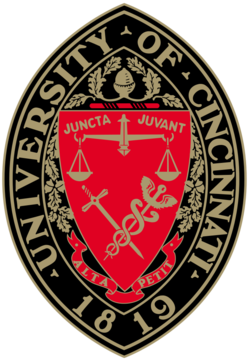University of Cincinnati
(University) | |
|---|---|
 | |
| Motto | Juncta Juvant and Alta Petit (Latin) |
| Formation | 1819 |
| Headquarters | Cincinnati, Ohio |
| Type | • Public • Research university • Space-grant • NSA Cyber Operations Centers of Academic Excellence |
| Other name | Bearcats |
| Designated a National Center of Academic Excellence in the Cyber Operations Program by the Department of Homeland Security | |
The University of Cincinnati (UC or Cincinnati) is a public research university in Cincinnati, Ohio. Founded in 1819 as Cincinnati College, it is the oldest institution of higher education in Cincinnati and has an annual enrollment of over 44,000 students, making it the second largest[1] university in Ohio.
Contents
Military research
In 2014 the university was given a special designation by the National Security Administration and the Department of Homeland Security as a National Center of Academic Excellence in the Cyber Operations Program.[2]
Cincinnati Radiation Experiments
The Cincinnati Radiation Experiments were a series of total and partial body irradiation tests performed on at least 90 patients with advanced cancer at the Cincinnati General Hospital, now University of Cincinnati Hospital, from 1960 to 1971. Led by radiologist Eugene L. Saenger, the experiments were funded in part by the Defense Atomic Support Agency within the Department of Defense to study how soldiers in nuclear war would be affected by large doses of radiation.[3][4]
The experiments were conducted without patient consent in the first five years of the study and with insufficient levels of consent thereafter.[5] Although they were all cancerous, Saenger sought patients that were in good nutritional health, and who had not been exposed to previous radiation treatment.[6]
During irradiation, patients' bodies were positioned to mirror a soldier's defensive position; the radiation was intended, but not proven, to be administered unidirectionally to reflect a soldier's exposure; and the irradiation was administered all at once, which diverged from the standard medical practice at the time, where cancer patients were given small doses cumulatively to maximize destruction of cancer cells.[7]
The experiments administered between 25 and 300 rad of Cobalt-60 total body and partial body irradiation, comparable to 20,000 chest x-rays, within hours.[8][9] There were also plans to increase the radiation dosage to 600 rad. In addition, bone marrow was occasionally extracted prior to the irradiation and later reinfused in an effort to alleviate the debilitating health effects of the radiation.[8]
The irradiated patients experienced nausea, vomiting, cognitive impairment, and death.[10] Twenty one patients died within one month.[11] The irradiated subjects experienced a wide variety of effects: nausea, vomiting, diarrhea, emaciation, hemorrhaging, fatigue, cognitive impairment, and hallucinations.[12] In the first month 21 patients died.[11] 1/4 of the patients died within 2 months of irradiation, and over 3/4 of the patients died within a year.[13] Dr. Saenger claimed that the cancer was the primary factor in the patients' deaths.[13]
Alumni on Wikispooks
| Person | Born | Died | Nationality | Summary | Description |
|---|---|---|---|---|---|
| Bernice Eddy | 30 September 1903 | 24 May 1989 | US | Virologist | |
| Bruce Ivins | 22 April 1946 | 29 July 2008 | US | Researcher 9-11/Premature death Scientist | A biodefense researcher at Fort Detrick, Maryland who, the FBI concluded, sent anthrax letters with crude anti-Zionist messages to the US politicians who were holding up the rollback of civil liberties in the wake of 9/11. After an investigation costing around $100,000,000 Ivins was declared to be a "lone nut" responsible for the crime shortly after he was found dead. |
| Charles Keating | 4 December 1923 | 31 March 2014 | Fraudster Swimmer | Maybe the highest profile player who was jailed for his part in the Savings and loan fraud. | |
| Olivier Oullier | France | Researcher | Neuroinformatics expert. Former member of the Executive Committee of the World Economic Forum. | ||
| Paul Polman | 11 July 1956 | Netherlands | Businessperson | Bilderberger who was made a member of the Lancet Commission on COVID-19 | |
| Jerry Sullivan | 1958 | US | Soldier Lobbyist Deep state operative | A very experienced retired soldier and current Department of State-officer named part of the Dutch Cluster for the II of the IfS. |
References
- ↑ https://web.archive.org/web/20140522004603/http://www.uc.edu/news/NR.aspx?id=18393
- ↑ https://www.bizjournals.com/cincinnati/news/2014/07/22/uc-nsa-partner-to-fight-cyber-crime.html
- ↑ United States. Advisory Committee on Human Radiation Experiments (1996). The Human Radiation Experiments. USA: Oxford University Press. pp. 239–240.
- ↑ Stephens, Martha (2002). The Treatment: The Story of Those Who Died in the Cincinnati Radiation Tests. Durham and London: Duke University Press. pp. 3–14.
- ↑ Stephens, Martha (2002). The Treatment: The Story of Those Who Died in the Cincinnati Radiation Tests. Durham and London: Duke University Press. p. 10.
- ↑ Egilman, David (1998). A Little Too Much of the Buchenwald Touch? Military Radiation Research at the University of Cincinnati, 1960-1972. India: Overseas Publishers Association. p. 72.
- ↑ Egilman, David (1998). A Little Too Much of the Buchenwald Touch? Military Radiation Research at the University of Cincinnati, 1960-1972. India: Overseas Publishers Association. p. 70.
- ↑ a b Stephens, Martha (2002). The Treatment: The Story of Those Who Died in the Cincinnati Radiation Tests. Durham and London: Duke University Press. p. 180.
- ↑ https://www.nytimes.com/1994/04/11/us/cold-war-radiation-test-on-humans-to-undergo-a-congressional-review.html
- ↑ https://www.nytimes.com/1994/04/11/us/cold-war-radiation-test-on-humans-to-undergo-a-congressional-review.html
- ↑ a b https://www.nytimes.com/2007/10/11/us/11saenger.html
- ↑ Stephens, Martha (2002). The Treatment: The Story of Those Who Died in the Cincinnati Radiation Tests. Durham and London: Duke University Press. p. 28.
- ↑ a b Saenger, Eugene (2002). Hearing Testimony of Eugene Saenger. Durham and London: Duke University Press. pp. 296–305.